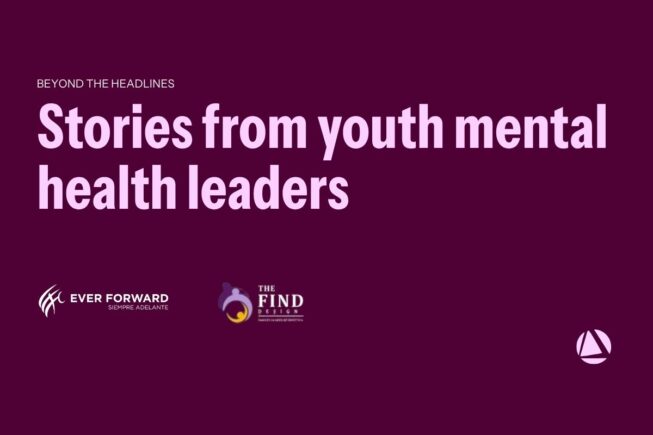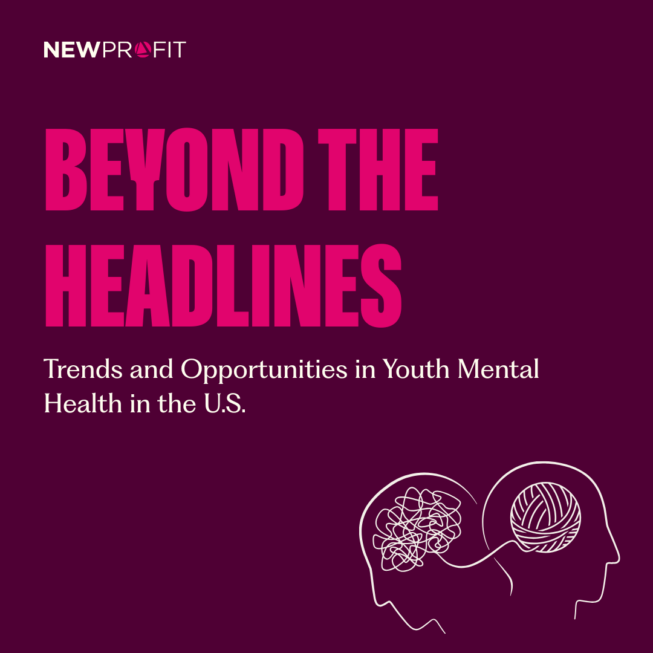Youth Mental Health: Increased Awareness, Persistent Barriers

In May, we published “Beyond the Headlines: A Deep Dive into Trends and Opportunities in Youth Mental Health,” a landscape analysis in partnership with human-centered design firm, People Rocket. This report provides a clearer picture of where funding is flowing, where the most pressing gaps remain, and how philanthropy can drive meaningful change in access and opportunity.
One of the key themes from the landscape analysis? The COVID-19 pandemic brought youth mental health into the spotlight, increasing public awareness, funding, and momentum across the field, yet awareness alone doesn’t close the gap. For many young people, especially youth of color, care is still difficult to access due to stigma, cost, and a lack of culturally responsive services.
Kara James, Co-Founder and Executive Director of The F.I.N.D. Design in Nashville, TN, and Ashanti Branch, Founder and Executive Director of The Ever Forward Club in Oakland, CA—both were part of New Profit’s Equitable Education Recovery Initiative Cohort—have both been working in youth mental health for years, long before it gained widespread attention, and long before many institutions were ready to engage. With their help, we explore what it takes to build connection and care in communities where stigma, cost, and culturally unresponsive systems still create barriers:
- Starting early: Both organizations focus on supporting youth mental health before a crisis point, not just after.
- Speaking their language: Young people trust adults who can act as cultural and generational translators–communicating in ways that truly resonate.
It’s not just about offering more services, but ensuring that those services are built with the language, leadership, and proximate lived experience of the youth they aim to support.
Start Early, Speak Their Language
At The F.I.N.D. Design, Kara and her team are intentionally building a different kind of mental health model that centers trust, sisterhood, and cultural relevance for Black girls. Their programs often begin in schools, because many of the girls Kara serves juggle caregiving responsibilities and can’t stay after class. “Our girls are navigating adultification, implicit biases, and…Black girls are more likely to be caretakers in their homes…[and] grow up faster,” she shared. So they bring care to them on their terms.
Many of those girls have long felt that traditional therapy wasn’t built for them. Kara shared that there’s collective trauma, generational silence, and a long history of feeling unseen in clinical spaces. Kara’s team meets that reality with group sessions led by culturally aligned facilitators who know how to create safety and belonging. Trust comes first, and once it’s built, interest in 1:1 therapy often follows. Some girls are so committed now that they hesitate to leave for school breaks, worried they’ll miss a session with their therapist.
That connection doesn’t happen by accident. The F.I.N.D. Design’s framework is rooted in cultural understanding and a grounded awareness of the systemic gaps Black girls face, especially in the American South. Kara calls it being a “cultural translator”: someone who knows how the mental health system works, but also is proximate to the experiences of the young people moving through it. She also pointed to data showing that, “from 2001 to 2017, the suicide rate for Black girls rose 182%, long before the pandemic.” She confirmed the pandemic didn’t start the problem; it just made it visible. “It took impacting others for them to really be seen. But our work didn’t start with headlines, it started with the experiences we’ve lived and seen every day.”
As Kara described the need for cultural translators, Ashanti often serves as a “generational translator” by bridging the gap between how adults speak and how young people hear. In Oakland, Ashanti and his team take a parallel approach with The Ever Forward Club, where the focus is on young men of color. They create spaces where talking about emotions isn’t taboo but expected. Through mentoring, life coaching, and honest conversations, Ashanti helps youth build emotional literacy and express feelings they’ve often been taught to hide. For instance, during his “Taking Off the Mask” workshops, participants write on the front of a mask how they think others see them, and on the back, they share what they’re really feeling inside. It’s a powerful, guided experience that helps people open up, reflect, and connect on a deeper level.

Unfortunately, he shared that many of the students he works with have become experts at wearing emotional “masks” by projecting happiness on the outside while carrying deep sadness underneath. In one school, 15 out of 88 students wrote “sad” as a description of what they feel inside, while every one of them wrote “happy” or “nice” as a description of the mask they wear and how they show up to others. “Because they’ve gotten so good at [wearing] the mask, what are they doing with sadness?” he asked.
He’s also clear about the structural problem: too often, systems and funders only invest after a crisis. “Why aren’t we funding prevention?” he asked. “Everyone doesn’t need a solution; they just need to be heard.”
That idea, starting earlier, is at the heart of both models. It’s not just about therapy access but also speaking the language of the communities being served, offering support in a format that resonates, and building relationships with adults youth can trust.
Both leaders are helping us see the full picture: increased awareness isn’t enough on its own. We need more investment in community-based models that are intentionally designed with and not just for the youth they serve.
Philanthropic giving to youth mental health in the US rose from just 0.32% of total private foundation giving in 2019 to 0.43% in 2022–a meaningful increase, but still small relative to the scale of need. Systemic barriers, workforce shortages, and disparities continue to prevent countless young people–particularly those from historically underserved communities–from getting the support they need. In 2023, nearly 60% of youth with depression did not receive treatment, according to Mental Health America. The challenge isn’t just about how much funding exists; it’s about ensuring funding supports solutions that truly break down these barriers.
Explore Part 2 & Part 3 of our series!
